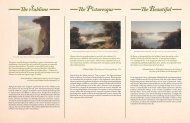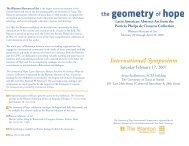“setting” for A. Pomodoro - Blanton Museum of Art
“setting” for A. Pomodoro - Blanton Museum of Art
“setting” for A. Pomodoro - Blanton Museum of Art
Create successful ePaper yourself
Turn your PDF publications into a flip-book with our unique Google optimized e-Paper software.
4.<br />
1.<br />
3.<br />
1.-5. <strong>“setting”</strong> <strong>for</strong> A. <strong>Pomodoro</strong>, 2006, detail (Courtesy <strong>of</strong> the <strong>Art</strong>ist,<br />
maccarone inc., and Galerie Dennis Kimmerich)<br />
A gallery space dedicated to exploring new developments in contemporary art. WorkSpace features<br />
commissioned projects by emerging and mid-career artists from around the world.<br />
2.<br />
at the <strong>Blanton</strong><br />
WorkSpace is generously supported by:<br />
Fluent~Collaborative<br />
Jeanne and Michael Klein<br />
Susan Vaughan Foundation<br />
Ellen and David Berman<br />
Kelley Cooper<br />
Deborah Green<br />
Peggy O’Shaughnessy<br />
Lora Reynolds and Quincy Lee<br />
Julie and John Thornton<br />
Ed Vaughan<br />
Alexa and Blaine Wesner<br />
Christine and Philip Dial<br />
Donald R. Mullins, Jr.<br />
Anne Elizabeth Wynn<br />
Additional support <strong>for</strong> <strong>“setting”</strong> <strong>for</strong><br />
A. <strong>Pomodoro</strong> is provided by: maccarone inc.<br />
Special thanks go to Shirley and Jay Marks <strong>for</strong> lending<br />
their Arnaldo <strong>Pomodoro</strong> sculpture to the exhibition.<br />
The University <strong>of</strong> Texas at Austin<br />
1 University Station D1303, Austin, Texas 78712<br />
(512) 471-7324 blantonmuseum.org<br />
Copyright © <strong>Blanton</strong> <strong>Museum</strong> <strong>of</strong> <strong>Art</strong>, 2006. All rights reserved. Photo credit: Rick Hall.<br />
Carol Bove<br />
<strong>“setting”</strong> <strong>for</strong> A. <strong>Pomodoro</strong><br />
July 21 through October 1, 2006<br />
at the <strong>Blanton</strong><br />
02
If we think <strong>of</strong> the events, beliefs, and experiences <strong>of</strong> the<br />
past as material, then history is most certainly Carol Bove’s<br />
primary medium. Since graduating from New York University<br />
in 2000, Bove has become known <strong>for</strong> a diverse body <strong>of</strong> work<br />
that includes haunting ink on vellum drawings <strong>of</strong> images culled<br />
from magazines <strong>of</strong> the 1960s and 1970s as well as elegant<br />
sculptures and installations that double as highly personalized<br />
archives <strong>of</strong> a period known to the collective imagination as the<br />
Sixties.<br />
July 21 through October 1, 2006<br />
For her exhibition at the <strong>Blanton</strong>, Bove has further synchro-<br />
nized her interests in history and sculpture by creating two<br />
miniature sculpture gardens, which were inspired by encoun-<br />
ters with the sculpture garden at the <strong>Museum</strong> <strong>of</strong> Modern <strong>Art</strong> in<br />
New York, designed by Philip Johnson in 1953. These depart<br />
from her other installations in the degree <strong>of</strong> their abstraction<br />
and the assertiveness <strong>of</strong> their physical presence. While all <strong>of</strong><br />
Bove’s works address the viewer visually and intellectually,<br />
the two at the <strong>Blanton</strong> are also phenomenological exercises,<br />
engaging the eye and mind via the body. They signal a shift in<br />
the scope <strong>of</strong> her previous historical investigations as well. No<br />
longer confining herself to the 1960s and 1970s, the artist<br />
has broadened her perspective to encompass the whole <strong>of</strong> the<br />
20th century, all the while remaining attached to the period<br />
that initially sparked her curiosity. Indeed, ins<strong>of</strong>ar as a sculp-<br />
ture by the Italian artist Arnaldo <strong>Pomodoro</strong> serves as the physi-<br />
cal and thematic anchor <strong>for</strong> the larger <strong>of</strong> the two installations,<br />
1963 (the sculpture’s approximate date) functions as the pivot<br />
around which its historical timeline revolves. Everything in the<br />
installation projects <strong>for</strong>ward or backwards from this point in<br />
history. (The fact that Bove shares her exhibition with another<br />
artist testifies to two other defining features <strong>of</strong> her work:<br />
first, its generosity to the ideas and <strong>for</strong>ms <strong>of</strong> other creative<br />
minds—Bove’s collaborators, as it were—and second, the<br />
modesty and temperance <strong>of</strong> its authorial voice.)<br />
Bove’s two sculpture gardens narrate a history <strong>of</strong> 20th-century<br />
art, but they do so in a way that re-enchants this familiar story.<br />
1 Beatrix Ruf, “Interview with Carol Bove,” in Carol Bove: Below Your Mind (Zürich: Kunsthalle Zürich, 2003), 172.<br />
First, they privilege intuition over facticity and strict<br />
rationality. Here we find Bove sifting through the<br />
past in an organic fashion, sensitive to moments <strong>of</strong><br />
connectivity and repetition, responsive to instances<br />
where the teleological view <strong>of</strong> art historical develop-<br />
ment stutters. Perhaps most importantly, Bove’s<br />
sculpture gardens proceed by allusion and asso-<br />
ciation thanks to the individual objects displayed<br />
within them. Besides the <strong>Pomodoro</strong> sculpture, these<br />
include pieces <strong>of</strong> steel, driftwood, and foam; irregu-<br />
lar lumps <strong>of</strong> wax; peacock feathers; railroad ties;<br />
Plexiglas and concrete cubes; square tiles made <strong>of</strong><br />
concrete and bronze; and brass plinths that <strong>for</strong>m<br />
open rectangles. The artist has said that she has a<br />
“sense <strong>of</strong> people [being] able to see through time by<br />
having physical contact with old objects. [Colin Wil-<br />
son] calls it ‘psychometry.’” And indeed, psychome-<br />
try is very much at play in Bove’s sculpture gardens,<br />
whose individual elements incite both the memory<br />
and fantasy <strong>of</strong> the viewer, raising the specter <strong>of</strong> dif-<br />
ferent artists, movements, and even particular works<br />
<strong>of</strong> art. More specifically, these “ambiance cues,” as<br />
Bove calls them, represent <strong>for</strong>ms that are associ-<br />
ated with the Surrealists and Constructivists <strong>of</strong> the<br />
early to mid-20th century but that were revisited by<br />
artistic movements <strong>of</strong> the 1960s and 1970s as well.<br />
There is a third chapter to the art historical narra-<br />
tive conveyed by Bove’s installations: a poster the<br />
artist designed to accompany, and comment upon,<br />
the exhibition as a whole. On one side is a grainy<br />
reproduction <strong>of</strong> a relief sculpture (1958-1964) by<br />
the Surrealist-turned-Constructivist artist Charles<br />
Biederman; on the other is an excerpt from a 1963<br />
essay, in which Biederman analyzes the significance<br />
2 They also allude to a Richard Lippold sculpture that hangs over the bar in the Four Seasons restaurant in New York. The Four Seasons is located in the<br />
Seagram Building, which was designed by Mies van der Rohe in collaboration with Philip Johnson in the late 1950s. In order to prepare <strong>for</strong> creating what<br />
was now conceived <strong>of</strong> as a constellation, Bove met with one <strong>of</strong> Lippold’s <strong>for</strong>mer studio assistants to discuss the specifics <strong>of</strong> the earlier project.<br />
<strong>of</strong> the sphere, fundamental (in his view) to both art and na-<br />
ture. The poster thus returns the viewer to the central motif<br />
<strong>of</strong> the <strong>Pomodoro</strong> sculpture, a globe whose “skin” has been<br />
removed to reveal a chaotic assembly <strong>of</strong> marks, incisions,<br />
and <strong>for</strong>ms. In this way, the poster completes the graceful<br />
circularity <strong>of</strong> Bove’s project.<br />
One <strong>of</strong> the distinguishing features <strong>of</strong> Bove’s work is its ten-<br />
dency to saturate objects and materials with an abundance<br />
<strong>of</strong> meaning and historical weight. Carl Andre, Sol LeWitt,<br />
Larry Bell, Anne Truitt, and John McCracken haunt both <strong>of</strong><br />
the installations at the <strong>Blanton</strong>, as do their predecessors<br />
who experimented with geometric abstraction and Construc-<br />
tivist principles in the earlier part <strong>of</strong> the century. Surrealism,<br />
as it was practiced be<strong>for</strong>e and after World War II by Max<br />
Ernst and Joan Miró, is present here, too. Allusions are<br />
made to Constanin Brancusi, Alexander Calder, and Mark di<br />
Suvero, while Alberto Giacometti is granted two doppelgang-<br />
ers. Bove has endowed the peacock feathers that appear<br />
throughout the exhibition with particular communicative<br />
weight. Here she weaves together elements from personal,<br />
ancient, cultural, and art historical narratives, including the<br />
story <strong>of</strong> Io, relayed by Ovid in the Metamorphoses, Ernst’s<br />
painted alter-ego, Loplop, and Aubrey Beardsley’s illustra-<br />
tions <strong>for</strong> the 1894 edition <strong>of</strong> Oscar Wilde’s play Salomé. The<br />
feathers also have bearing on the 1960s: Beardsley was the<br />
subject <strong>of</strong> renewed enthusiasm during this period, while a<br />
contemporaneous trend in men’s fashion was designated<br />
the Peacock Revolution.<br />
WorkSpace 02: <strong>“setting”</strong> <strong>for</strong> A. <strong>Pomodoro</strong> Curated by Kelly Baum<br />
Carol Bove <strong>“setting”</strong> <strong>for</strong> A. <strong>Pomodoro</strong><br />
Many <strong>of</strong> the quixotic protagonists that populate Bove’s<br />
sculpture gardens are vaguely anthropomorphic in scale,<br />
while others are endowed with expressive, poignant <strong>for</strong>ms<br />
that allow them to function as sites <strong>of</strong> empathetic identifi-<br />
cation on the part <strong>of</strong> the viewer. Exacerbating the anthro-<br />
pomorphism <strong>of</strong> these objects are the plat<strong>for</strong>ms (strongly<br />
reminiscent <strong>of</strong> stages or theater settings) on which they are<br />
displayed. The “choreography” that takes place on these<br />
two stages exemplifies Bove’s environmental approach to<br />
Carol Bove was born in Geneva, Switzerland, in 1971, and currently lives in New York.<br />
Kelly Baum is Assistant Curator <strong>of</strong> American and Contemporary <strong>Art</strong> at the <strong>Blanton</strong> <strong>Museum</strong> <strong>of</strong> <strong>Art</strong>.<br />
art, which is nourished by her study <strong>of</strong> interior design<br />
and architecture. The artist orchestrates colors,<br />
<strong>for</strong>ms, materials, and objects in order to generate a<br />
subtle rhythm—a sense <strong>of</strong> variety within harmony,<br />
a sense <strong>of</strong> repetition punctuated by moments <strong>of</strong><br />
surprise, incongruity, and even the occasional<br />
“flaw”—that alternately arrests and then releases<br />
the eye. In expanding this rhythm to encompass the<br />
whole <strong>of</strong> the exhibition, Bove has not only synchro-<br />
nized the works <strong>of</strong> art with the gallery in which they<br />
are installed, she has trans<strong>for</strong>med what was initially<br />
a reticent white cube into a space infused with sen-<br />
suousness, human warmth, and subtle psychological<br />
undercurrents.<br />
While registering the movement <strong>of</strong> (art) history,<br />
Bove’s sculpture gardens also measure the passage<br />
<strong>of</strong> time. Suspended above the smaller <strong>of</strong> the two<br />
installations is a canopy covered in white suede to<br />
which 214 luminous bronze rods have been at-<br />
tached. The arrangement <strong>of</strong> these rods recreates<br />
a specific celestial event: on March 2, 2006, at 9<br />
pm, they aligned with the stars congregating over<br />
the Berlin gallery in which the installation was then<br />
being exhibited. On the one hand, this portion <strong>of</strong> the<br />
work reverses the conventional relationship between<br />
human beings and the cosmos, between interiority<br />
and exteriority. Here the universe is scaled to the<br />
body and, by extension, contained within that which<br />
it normally contains: the gallery. It is, quite literally,<br />
a microcosm. This canopy <strong>of</strong> ersatz stars is also, as<br />
Bove has described it, a horoscope—understood in<br />
its etymological sense as a view (“scope”) onto an<br />
hour (“hora”). The term applies to Bove’s two sculp-<br />
ture gardens as well, which likewise provide views<br />
onto time—in these cases, glimpses onto a slightly<br />
uncanny, eccentric history <strong>of</strong> the 20th century.













